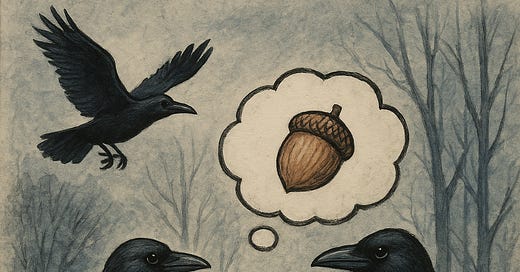A couple of days ago, I published a co-authored article titled “Dimensions of Corvid Consciousness” in the journal Animal Cognition. It is one of the first science papers on animal consciousness that doesn’t just ask whether some species is conscious or not, but actively asks the question of what their experiences consist in.
While I am a philosopher, I spent about half a year during my doctoral studies in Nicola Clayton’s comparative cognition lab, which has become famous for their investigations of the cognitive capacities of birds, and especially corvids.
Corvid, or Corvidae, is the scientific name for the family of birds including crows and ravens. Next to parrots, they are often admired for their high intelligence, something akin to “feathered apes.”
But in this article, we wanted to ask what their subjective experiences might be like, not just how smart they are. We examined five dimensions of their conscious experience that have earlier been proposed by Jonathan Birch, Nicola Clayton, and Alexandra Schnell as a means to map the experiences of other animals.
First, their sensory richness. That is, how detailed and varied the conscious senses of these birds are. While corvids have great visual capacities, it will be surprising to many that their sense of smell appears to be well developed. While there have been only a few studies on olfaction (smell) in corvids, they appear to make use of it when trying to find food.
Second, we discussed the evaluative richness of corvid consciousness. This dimension concerns the variety and intensity of emotions and moods. Consider, for instance, such states as pleasure, pain, curiosity, fear, and boredom. Corvids appear to have high emotional complexity, seemingly influenced by the negative mood of others.
Third, we examined their synchronic unity, which can be understood by virtue of how unified and integrated the experiences of these birds are. Human experience is highly integrated, but birds have fewer connections and more specializations between the halves of their brains, which could suggest more disunity, though more research is needed here to draw any confident conclusions.
Fourth, we discussed their diachronic unity. How unified are their experiences across time? Animals are often described as living in the present, but corvids engage in a lot of caching. They gather and hide food for the future. Dozens of experiments on this capacity have revealed corvids to have incredible memory capacities and the ability to plan for the future. This is suggestive that their experience is more akin to a continuous self across time.
Fifth, we tried to answer the difficult question of how much self-awareness these birds have.
California scrub-jays, a type of corvid, have been shown to re-cache their food if they are aware of others in their surroundings when they originally cached their food. This suggests that they have a theory of mind. They model the mental states of others. Furthermore, corvids have shown some success in mirror self-recognition tasks that are often used within this context.
We discuss many more studies in the article, to create a fuller picture of their experiential profile, which I can only recommend to anyone interested in the topic.
This blog entry appeared originally on Psychology Today, after editorial review and editing.
References
Veit, W., et al. (2025). Dimensions of corvid consciousness. Animal Cognition. 28(35). https://doi.org/10.1007/s10071-025-01949-y




The inaugural posts at my blog back in early April of 2023 show my perhaps inordinate fondness for crows and ravens in particular. Here are the respective posts: https://psodmusings.wordpress.com/2023/04/06/crows-ravens-part-1-of-2/ and https://psodmusings.wordpress.com/2023/04/07/crows-and-ravens-part-2-of-2/
And I will soon be adding your co-authored article on corvid consciousness to my transdisciplinary bibliography on animal ethics, rights, and law: https://www.academia.edu/4843888/Animal_Ethics_Rights_and_Law_bibliography
This is fantastic. When in grade school, our kid did a project on Corvus brachyrhynchos. What a fascinating species!
At least at this point in my life, I think advocating for birds is the sweet-spot for helping reduce cruelty to animals.